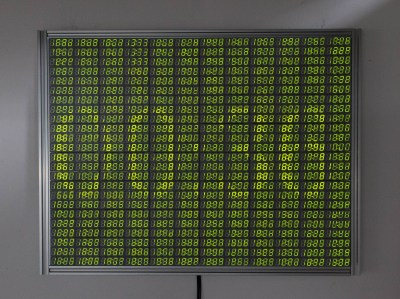If you look around your desk right now, odds are you’ll see a 7-segment display or two showing you some vital information like the time or today’s weather. But think of how much information you could see with over 1,100 digits, like with [Chris Combs’] 7200-segment display.
For [Chris], this project started the same way that many of our projects start; finding components that were too good of a deal to pass up on. For just “a song or two plus shipping”, he was the proud owner of two boxes of 18:88 7-segment displays, 500 modules in total. Rather than sitting and using up precious shelf space, [Chris] decided to turn them into something fancy he could hang on the wall.

The second challenge was how to actually wire everything up. The finished display comes out to 26 inches across by 20.5 inches tall, much too large for a single PCB. Instead, [Chris] opted to design a series of self-contained panels, each with 6 of the display modules and an IS31FL3733 to drive them. While the multiplexing arrangement did leave space for more segments on each panel, he opted to go for this arrangement as it resulted in a nice, clean, 4:3 aspect ratio for the final display.
The end result was a unique and beautiful piece, which Chris titled “One-to-Many”. He uses it to display imagery and art related to the inevitability of automation, machines replacing humans, and other “nice heartwarming stuff like that”, as he puts it. There’a video after the break, but if you are interested in seeing the display for yourself, it will be on display at the VisArt’s Concourse Gallery in Rockville, MD from September 3 to October 17, 2021. More info on [Chris’s] website.
This isn’t [Chris’s] first adventure in using 7-segment displays in such a unique way, click here to read about the predecessor to this project that we covered last year.















Absolutely gorgeous! It is nice to see electonics and art together.
That is awesome! Really a neat original approach…
What an spectacular device! That particular LED green reminds me of so many things I took apart in my early electronic adventures like radio clocks and stuff like that.
Hm, at 20mA/segment that is a wopping 144A current with all segments on. 8(
Isn’t 20mA the consumption for a whole 18:88 display instead?
Powering this thing has been a real struggle! But the good news is that the controller IC multiplexes at 1/12, so only a twelfth of the segments are on at any given time.
Because of the multiplexing it’s possible to push more than 20mA, though, so I’m giving it around 40mA for more brightness. these old displays are quite inefficient!
I am powering it with a 5V/40A supply and have set an overall power budget for myself of 20A. In practice it’s pulling ~10A at most times.
Aiming to write up my power woes in a .io project post, follow along over there if this is of interest…
Cheers,
Chris
Wow, impressive numbers. After all it’s not meant as a living room 24/7 display, right? Taking 40W as an average power draw it would cost around 100€/year running 24/7 where I live…
I’d love to see that display in person!
thank you! Yeah, it would certainly light up the living room at night :) I have made some hardware and software provisions for a nrf24l01+ remote control to turn it off and on.
Quite a beautiful display!
Left most digit only has 2 segments ;)
My apologies, Jan… I didn’t include the 2 LEDs for each colon. You are correct.
What about some matrix animation in greenscale.
I was actually quite expecting some digital rain behind the clock. Now envisioning this done with sixteen segment displays. As if this wasn’t already a soldering/driver nightmare. At least it’s not wirewraped. But saying that, it would be a thing of beauty, if more certainly a labour of love.
I’ve seen the work in person, and it’s stunning proof that art and science aren’t antagonistic. Quite the opposite, actually…
brownie points if you can run doom on it.
Next project, use RGB 7 segment displays.
I’d love to. Just need to find a couple bags full of gold first. ;)